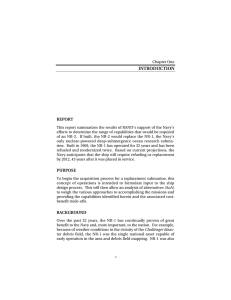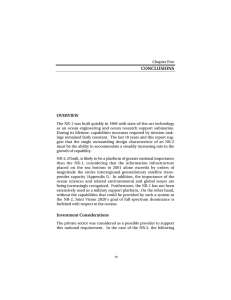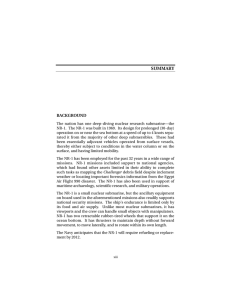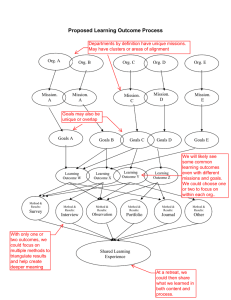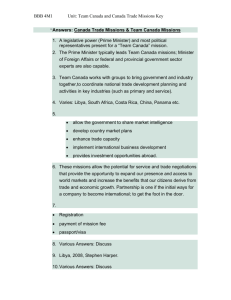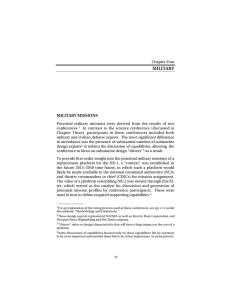CONOPs FOR NR-2 MILITARY AND SCIENCE SUPPORT MISSIONS PURPOSE
advertisement
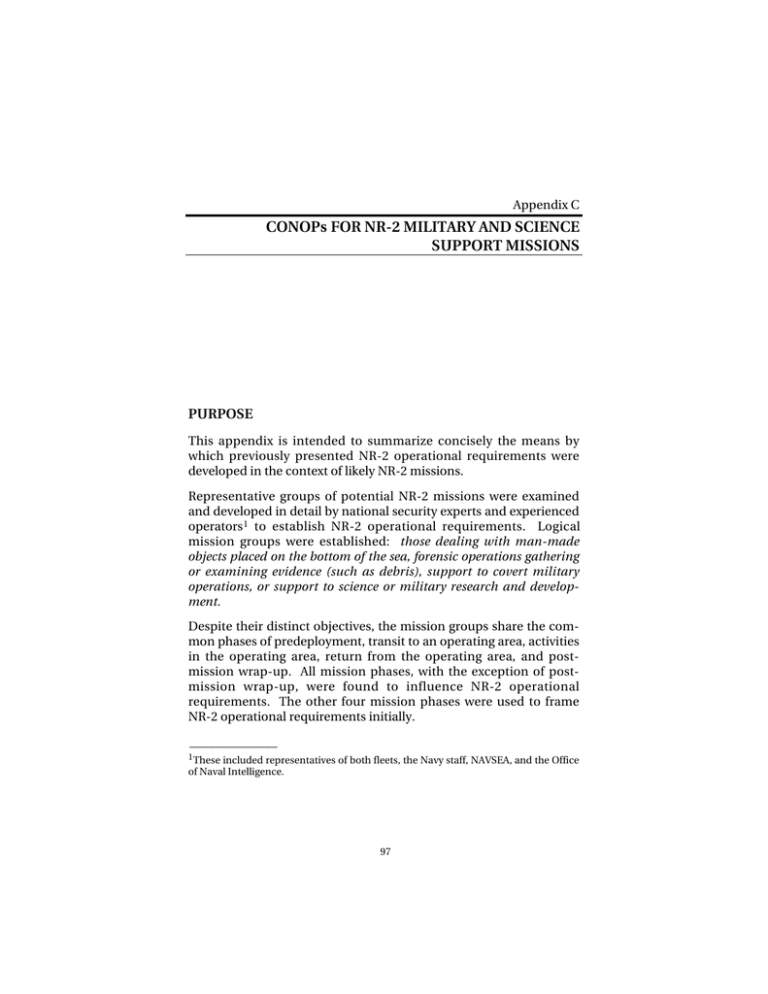
Appendix C CONOPs FOR NR-2 MILITARY AND SCIENCE SUPPORT MISSIONS PURPOSE This appendix is intended to summarize concisely the means by which previously presented NR-2 operational requirements were developed in the context of likely NR-2 missions. Representative groups of potential NR-2 missions were examined and developed in detail by national security experts and experienced operators 1 to establish NR-2 operational requirements. Logical mission groups were established: those dealing with man-made objects placed on the bottom of the sea, forensic operations gathering or examining evidence (such as debris), support to covert military operations, or support to science or military research and development. Despite their distinct objectives, the mission groups share the common phases of predeployment, transit to an operating area, activities in the operating area, return from the operating area, and postmission wrap-up. All mission phases, with the exception of postmission wrap-up, were found to influence NR-2 operational requirements. The other four mission phases were used to frame NR-2 operational requirements initially. ______________ 1 These included representatives of both fleets, the Navy staff, NAVSEA, and the Office of Naval Intelligence. 97 98 A Concept of Operations for a New Deep-Diving Submarine ASSUMPTIONS A minimal NR-2 capability was used as a baseline over which additional requirements were applied. Missions were determined to require up to 45 days of operation on station.2 Military missions were projected to be conducted from Groton, Connecticut, or Pearl Harbor, Hawaii. 3 Total endurance of about 60 days, including transit time, was derived. Initial mission planning was assumed to reflect NR-2 capabilities—it would not be given a mission beyond its capabilities (including endurance) or which it could not conduct safely. NR-2 transits to and from operating areas, exclusive of tug support or mooring upon return, could be conducted with or without outside support. Similarly, on-station activities could be conducted with or without outside assistance. All combinations of outside support were examined. Any offensive weapons or mines were not assumed to be stored inside the NR-2 pressure hull. MISSION PROFILES BY PHASE Predeployment A six-month predeployment period is anticipated as typical for planned NR-2 missions. Any equipment to be installed, as well as equipment responsibility, will be identified at the outset. Equipment decisions might reflect regional threat assessments along with mission objectives. Insertion of new equipment could be expected to impact tightly integrated existing equipment or overall NR-2 operation. Maximum NR-2 depth or speed, for example, could be limited. Such impacts will be evaluated prior to equipment installation. Also, any temporary modifications to NR-2 required for new equipment will also be evaluated prior to equipment installation. ______________ 2 This requirement was derived from a review of prior NR-1 classified and unclassified missions combined with a projection of future mission profile requirements to include transit times. 3 To help put these home port assumptions as well as military missions in context, refer to Khalilzad and Lesser (1998) and Khalilzad et al. (2001). CONOPs for NR-2 Military and Science Support Missions 99 Newly installed equipment will normally be tested at sea and the crew trained in its operation before the ship deploys on a mission, and projected operational limitations will be verified. If the NR-2 is to be towed by or mated to another ship for a transit, ability to operate in those modes will be demonstrated at planned speeds. Specialists might also be required for some missions. They will be selected before the predeployment phase and integrated into the ship’s crew during this phase. Becasue space on NR-2 will be at a premium, mission specialists may replace crewmembers for selected tasks. Any unique mission objectives and any operational constraints imposed by new equipment will be codified in orders to the crew. They will be tested using installed equipment shortly prior to departure, using a “Fast Cruise” conducted in port, with at-sea conditions simulated and all required equipment placed in service for test. Transit to the Operating Area Safe operation and adherence to local regulations will always be required as NR-2 leaves port. A level4 of seaworthiness on the surface, running lights, and navigational radar will be required.5 NR-2 missions could be delayed by inability to operate safely on the surface. If the NR-2 is to transit to the operating area with a support ship, they will rendezvous before beginning their transit. This would require modest navigational capability on the part of NR-2, but after the rendezvous the support ship could assist the NR-2 in navigation. A support ship could also reduce NR-2’s ship-to-shore communication burden during the transit. Under some threat conditions, NR-2 and any escort may have to operate quietly as they approach an operating area. ______________ 4 For purposes of analysis and design, the required level of seaworthiness is considered to be ability to operate on the surface in Sea State 6, using the Beaufort number system. Sea State 6 here corresponds to strong breezes of about 25 knots, with rough seas having wave heights of 8 to 13 feet (Maloney, 1985). 5 NR-1 operates under a waiver of rules governing the location and height of running lights. Failure to meet safety requirements could result in a requirement that NR-2 exit and enter ports accompanied by an escort that meets Rules of the Road requirements. 100 A Concept of Operations for a New Deep-Diving Submarine The crew will normally rehearse the mission and practice operating within any new guidelines required by new equipment during the transit. In this period the crew might also work out planning details and contingency plans. Simulation equipment and general-purpose computers may be required for these activities. The Marginal Ice Zone of broken ice surrounding the Arctic icecap could present a threat to the NR-2 in transit. On entering the Marginal Ice Zone, or crossing the Arctic “ice edge,” NR-2 will operate deep enough to avoid the ice and will monitor surface ice with a multipurpose sonar suite. Under-ice operations at high latitudes present navigational challenges. The NR-2 will take a last fix before going under the ice, and will subsequently be required to depend on inertial navigation for long periods. Extra sensors for under-ice navigation and communication may be required. Surface ice could also threaten onboard systems and sensors, so NR-2 must be prepared to deal with surface ice. If the operating area poses a (military or environmental) threat to any support ship or if the mission plan calls for NR-2 to operate alone, the two ships will separate, and NR-2 would subsequently operate autonomously. Transits will provide opportunities for any specialists added to the crew to assure proficiency and equipment readiness. NR-2 will transition to an operating mode suited for the operating area as it approaches that area. It might, for example, decrease speed and increase depth. For missions in support of covert operations, covert communications to update tactical intelligence and any mission updates will be required just prior to entering the operating area. NR-2 may simultaneously launch a tethered communication buoy for emergency communications with its support team. Operations on Station As always, safety will be paramount throughout NR-2 missions, so unsafe activities will not be planned. NR-2 must be able to conduct planned activities safely. NR-2 is assumed to operate autonomously while on station. It may have to avoid detection and so must be able CONOPs for NR-2 Military and Science Support Missions 101 to operate quietly at operationally suitable speeds and may have to follow prescribed tracks. It may have to monitor activities in the operating area to avoid possible threats. Any remotely operated vehicle to be used in this phase will be tested as the NR-2 arrives in its operating area. The four mission groups (dealing with man-made objects on the bottom of the sea, gathering or examining evidence, support to covert military operations, or support to science or military research and development) generate distinct requirements in this phase. Missions Dealing with Man-Made Objects on the Bottom. In missions dealing with man-made objects on the bottom, the NR-2 could be required to conduct a site survey to determine a suitable placement site. The site must be suitable for NR-2 operation while placing the object and must be suitable for object operation. Site surveys require the ability to cover significant distances over the bottom while examining it. NR-2 must be capable of deploying objects in suitable locations. Careful placement of objects on the bottom and their manipulation once on the bottom will be required. These missions can also require relocating objects previously placed on the bottom and recovering them. A requirement exists for precise navigation as the NR-2 descends and operates over the bottom. Manipulation can include maintenance, operation, and repair—all requiring manipulator dexterity. The NR-2 may be required to maintain a fixed position (by hovering or opposing currents) to manipulate objects. Ability to hold a position on the bottom might be required. Conversely, NR-2 may be required to maneuver precisely on or near the bottom to manipulate objects from suitable vantage points. If an adjuvant vehicle (such as an ROV/AUV) is used to manipulate the object, ample lighting may be required to illuminate objects to be manipulated. Site restoration may be required to conceal activities in the area. Support to Covert Military Operations. Of the four groups of missions, only these missions would have on-station operations conducted exclusively in hostile waters (defined as waters in which a nearby country with interests inimical to the United States has demonstrated or given evidence of an ability to control the seas). While on station, the NR-2 might interfere with identified targets 102 A Concept of Operations for a New Deep-Diving Submarine (possibly including keeping them from getting under way without the use of violence). It might also tag identified vessels in port to allow easier tracking at sea. Offensive weapons, such as mines, might also be used in support of Special Operations Forces activities. External weapon capacity would be required in that case. NR-2 will be expected to support covert IPB or covert ISR operations. NR-2 will communicate covertly while operating on station. NR-2 will seek to minimize its time in hostile waters in the conduct of its mission. Both acoustic and nonacoustic stealth will be stressed. NR-2 will be expected to avoid detection, especially by threat submarines and tripwire systems, and to be able to break threat contacts and escape. Evasion and escape plans will be developed and wellrehearsed in predeployment training, along with plans for dealing with a target it has inadvertently alerted or that has become aware of its mission through some other means. Loss of an adjuvant vehicle is readily acceptable in noncovert operations but a response to this eventuality must be carefully preplanned and exercised prior to the mission. Thorough site restoration may be required before leaving the operating area. Forensics Missions. NR-2 could collect water samples at varying depths, sample the bottom, or locate and retrieve evidence or analyze it on site in forensics missions. An initial search will be conducted to identify potentially interesting objects, AOIs, or bottom hazards. It would operate at speeds suited to its search sensors consistent with any security requirements and time available for search. NR-2 must maintain a safe distance above the bottom in search but stay close enough to the bottom to search effectively. When using an adjuvant vehicle NR-2 must simultaneously operate the vehicle or monitor its activities. For tethered vehicles it must also monitor the tether. NR-2 must rendezvous with an untethered vehicle when it has completed its programmed search. In either case, NR-2 must be prepared to retrieve the vehicle and may have to recharge it or replenish its power supply. Additional lighting may be required to identify objects, AOIs, or hazards. Their locations must be recorded so they can be relocated or avoided later. Navigation accuracy must also be good enough to ensure a thorough area search. NR-2 must be able to record other information and results gathered in the search. Objects of interest and AOIs would subsequently be investigated in greater detail while avoiding identified hazards. With a high CONOPs for NR-2 Military and Science Support Missions 103 priority placed on navigation accuracy, NR-2 may have to refresh its navigation system with position updates. NR-2 may have to lift heavy objects, store recovered objects, or uncover buried or partially buried objects in the course of these missions. Site restoration may be required for security. Support to Science or Military R&D. These missions can be as simple as taking instruments and test objects to depths of interest. They could entail observing system performance under conditions of interest or using NR-2 as a surrogate for another platform. An accurate navigation system may be needed to achieve planned test geometries or to reconstruct exercise geometries. It may be necessary to uncover or bury objects in support of science. The special demands of support to covert military operations are clearly orthogonal to the demands of the other missions in the sense that the NR-2 would not benefit from the capabilities required for other missions (such as the ability to operate deep on or near the bottom) in performing other missions. Similarly, the other missions would not benefit from the special demands of support to covert military operations (such as nonacoustic stealth). This suggested that missions supporting covert military operations should not be considered core NR-2 missions. Return Transit Extra sensors or navigational equipment may be recovered before starting return transit. If a support ship entered the operating area with the NR-2, the two will rendezvous and return to port together. Mission data preparation may be necessary during the return transit. It may also be necessary to remove special installations and restore the NR-2 to a normal configuration during the return transit. If so, testing restored systems will also be necessary. Finally, it may be necessary to shut down equipment installed for the mission. SUMMARY The means by which previously presented NR-2 operational requirements were developed were presented in a condensed form 104 A Concept of Operations for a New Deep-Diving Submarine in this appendix. Absence of a possible requirement in the context of a group of missions does not mean that there is no such requirement. For example, although not mentioned, precise navigation would be required for support to covert operations. Its need is overshadowed by other requirements, and so it was omitted. The actual process of deriving requirements worked at the checklist level of detail. All mission phases, with the exception of postmission wrap-up, were found to influence NR-2 operational requirements. NR-2 requirements were derived iteratively—starting from the assumptions that NR-2 would have 60 days of endurance and that it would not be given a mission it could not conduct safely. Missions involving man-made objects placed on the bottom of the sea, forensic operations gathering or examining evidence, and support to science or military research and development were found to have overlapping and mutually compatible requirements. Their requirements were largely irrelevant to the other group of missions as defined in this study—those supporting covert military operations. Conversely, requirements for missions supporting covert military operations were largely irrelevant to the other mission groups. This again suggested that missions not on the ocean bottom should not be considered core NR-2 missions.
